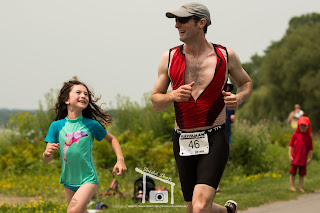 But, c'mon, this is me. I brought my camera along. And I decided that, rather than just getting shots of things that looked interesting, I would try and capture as many competitors as I could. For many folks, the sprint distance triathlon on the first day was their introduction to triathlon. So, all sorts of fun would be going on. For others, the half Ironman distance on the second day would be one of their big sporting achievements. Sounds like fun to capture! (You can view the results from the Sprint, and the Half Ironman.)
But, c'mon, this is me. I brought my camera along. And I decided that, rather than just getting shots of things that looked interesting, I would try and capture as many competitors as I could. For many folks, the sprint distance triathlon on the first day was their introduction to triathlon. So, all sorts of fun would be going on. For others, the half Ironman distance on the second day would be one of their big sporting achievements. Sounds like fun to capture! (You can view the results from the Sprint, and the Half Ironman.)Amazingly, I planned ahead for this. I packed my laptop, and made sure that it was fully charged. Why on earth would I want my laptop with me, you might be wondering?
Simple - I wanted to ensure that I always had space on my memory cards. As I filled one up, a quick eject during a quiet moment, slip it into the SD card slot, and transfer away. This is where a camera like my Nikon D7100 is really awesome - it has slots for two memory cards.
 Now, if you're doing an event, it is probably wiser to select that second slot as a backup to your main memory card (just make sure that the second card is the same size or bigger as the first!). I, however, am not wise, and just used the second card as standard overflow space. This allowed me to keep shooting as I transferred photos to my laptop.
Now, if you're doing an event, it is probably wiser to select that second slot as a backup to your main memory card (just make sure that the second card is the same size or bigger as the first!). I, however, am not wise, and just used the second card as standard overflow space. This allowed me to keep shooting as I transferred photos to my laptop.The real work, in an event like this, comes when you get home, and have to sort through several thousand images (yeah, I was busy). I've competed in a number of races, and always get sent proof pictures from race photographers to purchase. By and large, these aren't artistic masterpieces - simple shots with no real framing aesthetic. I made a very conscious decision to NOT do this with my own photos. Which meant a lot of work in Lightroom.
A lot.
So workflow mattered here. And I did have to change how I normally do things. Did I individual edit every photo? Nope. Did every photo get edited? Yep. Here's how:
1) I began with a single photo, and edited it to look "nice" - Temperature, Contrast, Highlights, Shadows, and Vibrance were the main settings I worked on.
2) I selected that photo. Then, while holding "Shift" (Windows users), scrolled through to the end of the block of photos that had the same camera settings (shutter speed and f-stop), and had similar lighting conditions. Still holding "Shift," I then click that last photo - this selects that whole block.
3) Ctrl + Shift + S - this lets me apply select settings from my first image to the whole block. So I select the ones which I edited.
4) Scroll through, select the shots I want to export from RAW to JPEG, and export.
5) Repeat for each block.
6) Sleep, because this was a TON of work!
I learned some invaluable lessons from this - I was never a big "optimize my workflow" guy with Lightroom. I didn't shoot enough to really care if I wasted button clicks. But with this kind of volume? Optimize, optimize, optimize!
Also, it became apparent that I should learn to harness all that Lightroom can do. It's not Photoshop, but it's still extremely powerful. So I went out and snagged a used copy of Scott Kelby's "The Adobe Photoshop Lightroom 4 Book for Digital Photographers." And now, to read!
Equipment Used
Nikon D7100 Camera70-200mm f/2.8 VR lens
Images



















































